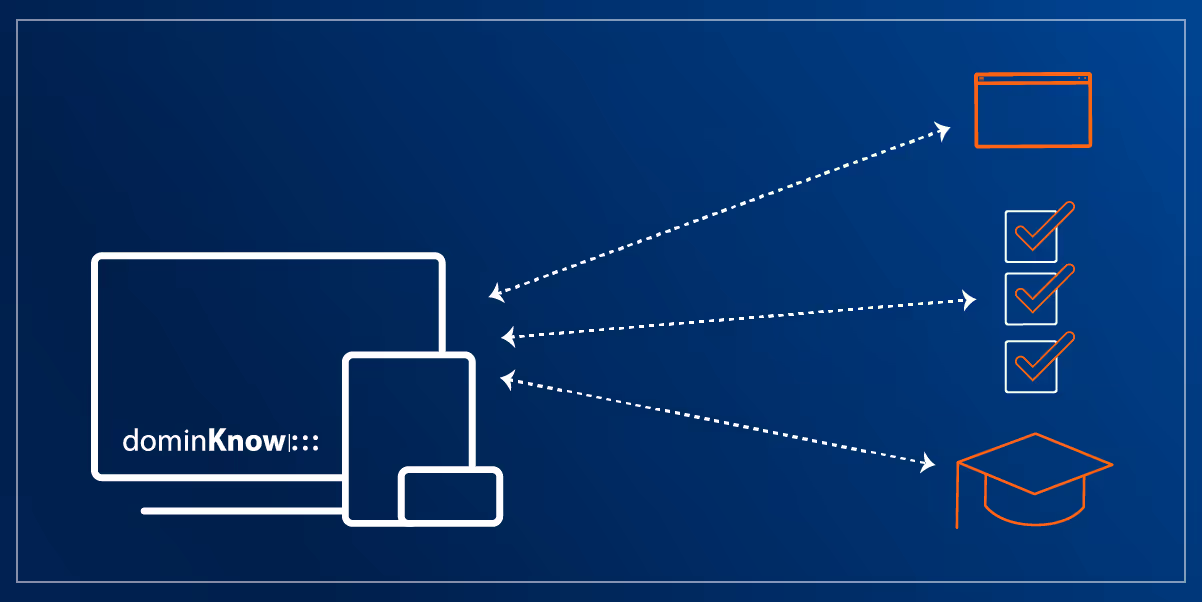SCORM vs xAPI vs cmi5: Which content standard is the best for eLearning?



Authoring eLearning courses comes with a set of decisions to make from the initial planning and analysis through to pushing the publish button.
As part of publishing, one of the key decisions you will need to make is how you wish to track key metrics like learner progress, content completion and assessment scores.
Choosing the most-suitable eLearning standard ensures that your course runs on your learning management system (LMS) efficiently, is scalable, and you also get the required metrics to evaluate the effectiveness of the course.
What are eLearning Standards?
eLearning Standards are a set of specifications and guidelines that determine the interoperability and compatibility of your digital learning courseware with different LMS, eLearning platforms, devices, and other technologies that store and use the courseware for training your employees. These standards ensure a seamless data, content, and resource exchange between different systems throughout the eLearning content development and distribution lifecycle.
Only top eLearning authoring platforms like dominKnow | ONE support all the eLearning standards: AICC, SCORM, xAPI and cmi5. Many factors come into play while determining the best eLearning standard for your courseware that supports the objective of the course. These factors include key parameters like delivery format, the extent of analytics and monitoring required, how the course will be consumed etc. Therefore, it is important to understand the different eLearning standards and their use cases.
In this article, we will dive into the details of the three most popular eLearning standards (SCORM, xAPI, cmi5), their advantages and disadvantages, and a comparative analysis to help you pick the one that best suits your needs.
What is SCORM?
SCORM is a technical specification for eLearning tools that stands for Sharable Content Object Reference Model. In 2000, the SCORM eLearning standard was developed to standardize learning content formats and solve the problem of spending too much time and money customizing content and distributing learning materials across various platforms. Most L&D professionals construct and design online courses and LMS platforms using SCORM specifications. Today, this is the most widely used standard within the eLearning community, and SCORM-compliant courses are compatible with most LMSs.
There are three key components that make SCORM the most preferred eLearning standard:
- Content packaging: This generates a ZIP file containing the course, making it easy to distribute to any SCORM-compliant LMS.
- Runtime: This initiates the course in a web browser, making it easy to deliver and consume digital content. Progress tracking can also be easily achieved through JavaScript APIs (Application Programming Interface).
- Sequencing: This determines the learning journey - how your learners navigate through the course, with features like previous, next, skip, table of content, etc.
Advantages
- Ease of content creation: SCORM content authoring tools are easy to use. A PowerPoint slide can even be turned into an interactive eLearning course without coding.
- Sequencing support: SCORM provides eLearning creators complete control over specifying criteria like how long a student must remain on a page or section before progressing, how long they must spend on a course, etc.
- Authoring tool and LMS support: Most authoring tools and LMS vendors support the most widely used SCORM 1.2 and the latest SCORM 2004 versions, making course creation and distribution straightforward.
- Course cataloguing: SCORM defines a basic set of information that allows you to construct content catalogues independent of the authoring tool or content source.
- Standardized archiving: This eLearning standard enables you to archive obsolete course content into simple and standard ZIP format.
Disadvantages
- No offline access: SCORM courses cannot work offline. A web browser with an Internet connection is a must for SCORM courses to work. A weak internet connection may also result in interruptions and dropouts as all the data and information exchange between the learner (client web browser) and the LMS happens via JS APIs over the Internet.
- Limited Mobile Support: SCORM tracking is only available through a compliant LMS and therefore offers limited mobile support depending on the LMS’s mobile capabilities.
- Limited tracking metrics and reporting capabilities: SCORM can only track course completions, total course duration, and assessment results, and for some use cases the reports you can build from SCORM data are limited.
- Old standard: SCORM 2004 was last updated (4th edition) in 2009, making it much older than other eLearning standards like xAPI and cmi5.
What is xAPI?
The Experience API (xAPI), also known as Tin Can API, was developed in 2013 and is an eLearning standard that allows collecting data about learners' varied experiences, both online and offline. This API gathers information about a learner's or group's actions using many different technologies in a standardized style.
This eLearning standard was developed to store and transfer learning data across other learning systems. xAPI allows for the automatic upload of training metrics to a standalone or an LMS-integrated LRS (Learning Record Store).
xAPI-compliant systems use "noun, verb, object" statements to communicate. These statements keep track of information about educational activities and inform the LRS of what transpired using a template, such as "user completed course 1."
Advantage
- Tracks rich learning data outside an LMS: The Experience API goes beyond simple course completion tracking via an LMS. This standard can track data from offline learning, game-based learning, simulation-based learning, blended learning and other learning activities.
- Extensive data capturing and exchange: xAPI allows storing and distributing learning data across LRSs. This information exchange can also happen between LRSs of different organizations; therefore, a more detailed learning map can be generated for a learner.
- Multi-device support: xAPI can track learners' activities regardless of the device being used. Mobile phones, games, hardware simulators etc., can send xAPI statements to an LRS.
- Records most learning activities: xAPI supports "nouns, verbs, and objects" statement-styled tracking, which can represent activities like "user completed test 1" or "user skipped module 2". This approach means the Experience API can practically record any learning activity.
Disadvantages
- Elaborate metrics: Since xAPI collects extensive data from several learning activities, it takes time to put up the proper performance analytics to benefit from the findings.
- Inability to measure learning impact: Despite the extensive data recording, the "nouns, verbs and objects" statements are insufficient to generate insight into activity-based learning impact.
What is cmi5?
Though xAPI is powerful and robust, it is not very specific and restrictive like SCORM when it comes to tracking learning. It makes Experience API too broad for its application in eLearning and tracking learning progress at a micro level where activity-based learning impact matters.
Bridging this gap between SCORM and xAPI, in 2016, cmi5 (Computer-Managed Instruction) was launched. cmi5 brings more structure to xAPI offering superior control and standardization for interoperability between eLearning platforms. This eLearning standard is also called an xAPI extension or xAPI profile that dictates how LMS and xAPI-powered learning systems and technologies communicate.
cmi5 uses XML metadata to specify course structure as a series of container blocks and Assignable Units (AUs). An AU is a launchable part of the course and can have the contents included or remotely hosted in a Content as a Service (CaaS) model.
Advantages
- Best of xAPI features: cmi5 has all the advantages of Experience API, like the ability to track offline learning, track learning across devices and platforms, reliability, etc. It also uses the latest technology stack to offer eLearning content development and delivery.
- Superior interoperability: cmi5 offers superior interoperability between authoring tools, LMSs, and other eLearning tools, making it easy for eLearning content authors to offer a seamless learning experience.
- CaaS model support: With cmi5, you can offload your learning content outside the LMS and still offer a seamless learning experience via a CaaS model.
- More structured data and precise statements: cmi5 features specific categories for the statements that capture session information, fundamentals of eLearning like pass/fail, content completion, time, and score, etc., which AUs may group.
Disadvantages
- Rigid constraints: In contrast to the general-purpose xAPI, cmi5 imposes limitations on sorting through enormous volumes of data.
What is AICC?
AICC is a 1988 legacy eLearning standard that was discontinued in 2014. This eLearning standard used simple text strings and HTML forms to communicate between course content and the LMS. Today, AICC is an obsolete eLearning standard still supported by many authoring tools and LMSs, but no real course progress tracking is available in this standard.
SCORM vs xAPI vs cmi5: Which is right for you?
The right approach to picking a learning standard depends on your unique needs, technical capabilities, and the learning experiences you want to provide. To assist you in making a wise choice, here's a comparison chart between SCORM, xAPI, and cmi5.
With its flexible and efficient nature, eLearning has become the go-to method for training, skilling and gaining knowledge across industries. However, simply creating an online course is not enough. It is important for the course to fulfil its purpose. Therefore, any eLearning course author or provider needs to ensure that their courseware has the right eLearning standards like AICC, SCORM, xAPI or cmi5 based on their need.
With the right eLearning standard, your course can be easily scaled, distributed, updated and adapted as needed. This also ensures the seamless gathering of insightful, actionable data on learning progress across devices.
Wondering how to create eLearning courses that work for your organization or customers - an audience that is experience-critical, always mobile, and has a wide range of devices to consume content from?
dominKnow | ONE is a content creation and knowledge management platform that enables you to author AICC, SCORM, xAPI, or cmi5-compliant eLearning courseware empowering your organization to provide training, information, and knowledge to employees, customers, and stakeholders wherever they are, whenever they need it.
Sign up for a demo with one of our experts to learn more about dominKnow | ONE's additional features or get started with a 14-day free trial!
Related Resources
.avif)
New to IDIODC?
Instructional Designers in Offices Drinking Coffee (#IDIODC) is a free weekly eLearning video cast and podcast that is Sponsored by dominknow.
Join us live – or later in your favourite app!
Is your training created, managed, and distributed flawlessly? Try dominKnow | ONE

.svg)






